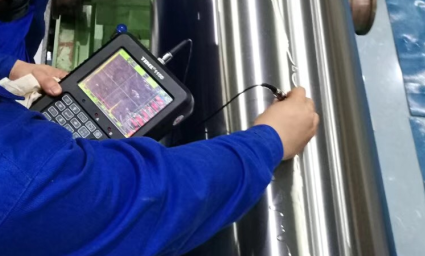Common roll flaw detection methods.
Roll flaw detection methods mainly include the following: magnetic particle flaw detection, penetrant dyeing flaw detection, eddy current flaw detection, ultrasonic flaw detection. The following will introduce them one by one.
1. Magnetic particle inspection
The magnetic particle inspection technique is mainly used to detect cracks on the roll body surface and fatigue cracks in the roll neck area, excessive cyclic loading or subsequent normal corrosion.
The principle of magnetic particle flaw detection: the principle of electromagnetism, the magnetization current forms an electromagnetic field through the surface of the ferromagnetic workpiece, the existence of the defect will cut off the magnetic force line, form a leakage magnetic field and absorb the magnetic powder, the magnetic powder accumulates to form a magnetic mark, and the existence of the defect (magnetic mark) is judged by observing the magnetic mark In essence, it is a magnified defect).

Advantages of magnetic particle inspection technology:
(1) Determine surface and subsurface linear discontinuity defects;
(2) Operation and interpretation are relatively simple.
Disadvantages of magnetic particle inspection technology:
(1) It can only be used on ferromagnetic materials;
(2) Flaw detection limited to surface defects.
2. Penetrant coloring flaw detection
Penetrant coloring flaw detection is widely used in roll surface crack inspection due to its simple use. The most common is a red dye, which can be applied by spraying. Provides a stark contrast against the white base.

Advantages of penetrant coloring flaw detection:
(1) No power supply is required;
(2) It can detect complex shapes and point out the shape and size of defects;
(3) It can display very few and dense defects;
(4) It can detect ferrous and non-ferrous metals.
Disadvantages of penetrant coloring flaw detection:
(1) Cannot detect subsurface defects;
(2) The surface must be clean, oil-free and dry.
3. Eddy current testing
Eddy current flaw detection is the first crack detection system developed and automated since the 1970s. It gives the grinder a clear and correct signal when surface cracks exist. It can also pinpoint the location of defects and the level of cracks. Since eddy current testing is mainly used to determine surface cracks.
Principle of eddy current testing: eddy current testing is a non-destructive testing method based on the principle of electromagnetic induction, which is suitable for conductive materials. When a conductor is placed in an alternating magnetic field, an induced current exists in the conductor, that is, an eddy current is generated. Due to changes in various factors of the conductor itself (such as electrical conductivity, magnetic permeability, shape, size, and defects, etc.), changes in eddy currents will result. Using this phenomenon to determine the nature and state of conductors is called eddy current testing.
Advantages of eddy current testing:
1. During detection, the coil does not need to contact the workpiece, nor does it need coupling medium, so the detection speed is fast.
2. It has high detection sensitivity for defects on the surface or near the surface of the workpiece, and has a good linear indicator within a certain range, which can be used for quality management and control.
3. It can measure the thickness of metal coating or non-metal coating.
4. It can test non-metallic materials that can induce eddy currents, such as graphite.
5. The detection signal is an electrical signal, which can be digitally processed to facilitate storage, reproduction, and data comparison and processing.
Disadvantages of eddy current testing
(1) Flaw detection can only be performed on conductive materials;
(2) The penetration depth is shallow;
(3) Many factors such as the geometry and permeability of the material will affect the signal. In some cases residual magnetism or other signal sources from magnetic particle testing can cause erroneous readings;
(4) The eddy current flaw detection device has a certain blind area (generally in the area where the detection starts and ends)
4. Ultrasonic flaw detection
In recent years, ultrasonic flaw detection systems for rolls have become widespread, and they have been combined and used with eddy current flaw detection as described above. Its main advantage is the ability to detect subsurface defects as well as detect defects at joints of composite cast rolls. In general, subsurface flaw detection is performed with a coupled crystal column probe. Water (oil) is used as a coupling agent in order to effectively transmit sound waves into the roll. Further development of surface wave and shear wave synthetic probes may replace eddy current testing.
Principle of Ultrasonic Flaw Detection: Ultrasonic flaw detection is a flaw detection method that uses physical characteristics such as propagation, reflection and attenuation of ultrasonic waves in materials to find defects. Ultrasonic flaw detection has the advantages of high sensitivity, fast detection speed, low cost, convenient operation, large detection thickness, harmless to human body and environment, especially high sensitivity to cracks, unfused and other dangerous defects. But there are also shortcomings related to the level and experience of the operator. In flaw detection, it is often used in conjunction with other flaw detection methods to improve the reliability of flaw detection results.

Advantages of Ultrasonic Flaw Detection
(1) It can penetrate to a considerable depth in many materials;
(2) Capable of flaw detection on the subsurface;
(3) Able to detect very small cracks;
(4) Relatively accurate in determining the size and depth of cracks;
(5) Portable batteries can be used to provide energy for operation;
(6) Ability to detect changes in internal defects.
Disadvantages of ultrasonic flaw detection
(1) A good couplant is required;
(2) Trained and experienced operators are required;
(3) Operators must have rich knowledge of defects.
Composition of ultrasonic flaw detection: Standard ultrasonic cleaning equipment consists of three parts: ultrasonic generator (also known as ultrasonic power supply), transducer and other auxiliary equipment.
Ultrasonic generator: It is what we often call flaw detector, which converts low-frequency electricity into high-frequency electrical signal above 28KHZ, and connects it to the transducer through the link line.
Ultrasonic transducer: known as the probe, is a high-efficiency transducer element that can convert electrical energy into powerful ultrasonic vibrations. When generating ultrasonic vibrations, it looks like a small piston with a very small amplitude, only about a few Microns. This is what we usually call ultrasound. Auxiliary equipment: link line, couplant, test block
Commonly used probes:
2M surface wave probes: used to detect cracks on the surface of rolls
2M of dual crystal probes: used to detect the thickness of the working layer of the roll
2M straight probes: used to detect internal defects of rolls
2M 45° angled probes: used to detect crack depth
Possible problems in ultrasonic flaw detection:
1. Since the ultrasonic wave will be affected by the unevenness of the measured object, the reflection angle and multiple reflections, it may increase the error of the measurement data.
2. Due to the inherent characteristics of ultrasonic waves in the measurement blind zone, if the measurement position changes but the received data remains unchanged during close-range measurement, it means that the measurement has entered the blind zone.
3. When ultrasonic waves measure distant objects, if there is no measurement data returned, it may be beyond the measurement range or the measurement angle is wrong. The measurement angle can be adjusted appropriately.
The advantages of a reasonable roll flaw detection process:
1 Cost saving
(1) Rolling mills that do not use roll flaw detection generally adopt open-loop grinding or turning when grinding rolls. Generally speaking, this means removing a standard depth of the roll surface. Necessary waste; if the defect is large, it may not be removed cleanly. After using the roll detection device, the minimum removal amount can be ensured, which is only 1/3~1/2 of the original under normal circumstances, which avoids unnecessary loss and ensures the grinding quality of the roll.
(2) It can reduce the downtime of the rolling mill, increase the service life of the roll, reduce the amount of scrap steel and the degradation of product quality due to crack propagation under normal operating conditions. After applying reasonable roll flaw detection, it can basically ensure that each roll is used to the guaranteed minimum size before being scrapped. In this way, it can be solved that many rolls could not be detected due to the existence of internal defects in the past, resulting in the expansion of defects, and finally many broken rolls or other accidents that seriously affected production.
2 Improve quality
The use of the roll flaw detection device means that the defects on the roll can be cleaned up, and at the same time, the integrity of the mechanical properties of the roll and the smoothness of the surface are guaranteed. In this way, it can be guaranteed that the quality of the product will not be reduced due to these reasons.








